Astronauts Submit Pet Images for Space Laser Communication Demonstration
NASA astronauts Randy Bresnik, Christina Koch, and Kjell Lindgren, and other NASA employees recently sent images and videos of their pets to the International Space Station (ISS) via the agency’s Space Communications and Navigation (SCaN) program to further test laser communications between ground-based stations and space-based systems, including the ISS. This demonstration holds the potential to further enhance laser communications systems that could be useful for long-term space missions.
For this demonstration, the SCaN program used its elaborate and coordinated system consisting of the High-Rate Delay Tolerant Networking (HDTN), which is run by NASA’s Glenn Research Center and capable of sending data at quadruple the speeds of current DTN technology; NASA’s Laser Communications Relay Demonstration (LCRD), which orbits at 22,000 miles above the Earth; and the Integrated LCRD Low Earth Orbit User Modem and Amplifier Terminal (ILLUMA-T) payload attached to the ISS.
Image collage of the photos and videos sent to the International Space Station via NASA's Space Communications and Navigation (SCaN) progra. (Credit: NASA/Dave Ryan)
“The pet imagery campaign has been rewarding on multiple fronts for the ILLUMA-T, LCRD, and HDTN teams,” Kevin Coggins, who is the deputy associate administrator and SCaN program manager at NASA Headquarters, said in a statement. “Not only have they demonstrated how these technologies can play an essential role in enabling NASA’s future science and exploration missions, it also provided a fun opportunity for the teams to 'picture' their pets assisting with this innovative demonstration.”
This latest test comes after NASA successfully sent a “Taters the Cat” video in December 2023 from the Earth to the agency’s Psyche spacecraft that was located approximately 19 million miles from Earth while en route to asteroid 16 Psyche.
How will the SCaN program help enhance laser communications for space missions in the coming years and decades? Only time will tell, and this is why we science!
As always, keep doing science & keep looking up!
Sources: EurekAlert!, NASA, NASA (1)









